Wastewater Ammonia Based Aeration Control
The introduction of simple, reliable, and affordable in situ sensors based on ion selective electrode (ISE) technology provides the opportunity for more advanced activated sludge control strategies. For example, aeration control using ammonium as a response variable in addition to or in place of dissolved oxygen (DO).
Ammonium-based aeration control has already been implemented at many 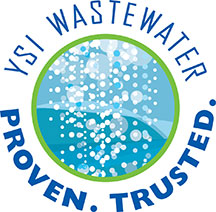 water resource recovery facilities (WRRF). Many more are wondering if it is right for them. The simple answer is that automation of aeration based on ammonium measurement would be beneficial for many facilities. However, the applicable control strategy for a particular facility depends on specific factors including system configuration, performance requirements (discharge limitations), and wastewater characteristics.
water resource recovery facilities (WRRF). Many more are wondering if it is right for them. The simple answer is that automation of aeration based on ammonium measurement would be beneficial for many facilities. However, the applicable control strategy for a particular facility depends on specific factors including system configuration, performance requirements (discharge limitations), and wastewater characteristics.
Here, we identify several control strategies. The approaches described offer the potential to enhance treatment performance, reduce operating costs and, in some cases, even generate revenue from nutrient credits.
Utilities have implemented ammonium-based aeration control based on feedback and feedforward strategies. Feedback control is based on measurement of the response whereas feedforward control is based on measurement of the disturbance. Feedback control is much more common in the water industry but can have limitations in a highly dynamic system like wastewater treatment. Feedforward control has greater complexity but offers the potential to achieve the best effluent quality at the lowest energy cost. Additional detail on feedback and feedforward control can be found elsewhere1 and 2.
Feedback Control - Direct
The simplest method is direct control of aeration based on feedback from the ammonium measurement. In this approach, the aeration rate is controlled directly based on the online ammonium measurement. The Wyoming Valley Sanitary Authority (WVSA) in Pennsylvania uses online ammonium ISE measurement to ensure nitrification is complete and to maximize nitrogen removal.
Blowers cycle on and off to maintain the ammonium-nitrogen concentration between setpoints of 0.7 mg/L and 1.0 mg/L in each of four treatment trains. Blowers are “off” 25% of the time with this strategy creating anoxic conditions for denitrification and saving about $20,000 per month in energy costs3. The substantial additional removal of nitrogen achieved is well below the permitted effluent load and generates nutrient credits that WVSA sells to other sources in the Chesapeake Bay watershed.
The success of the WVSA application using direct control can be attributed to the completely mixed (CM) configuration of the treatment system, the built-in mixing capability of the Schreiber counter-current system, and the simple control law (on-off). This strategy may not be optimal for many applications, however.
The drawback to direct control using ammonium is that the DO concentration is not controlled. Failing to also optimize DO causes inefficiency because DO varies more rapidly than ammonia and, therefore, can rise or fall to undesirable levels. The rate of nitrification increases proportionally with DO concentration up to about 1.5 to 2.0 mg DO/L. However, above a DO of 2.0 mg/L only a marginal increase in the nitrification rate is achieved (See Figure 1). Furthermore, a higher than needed DO is detrimental to denitrification. Therefore, if DO isn’t optimized, nitrification capacity is limited or denitrification capacity is limited and energy is wasted.
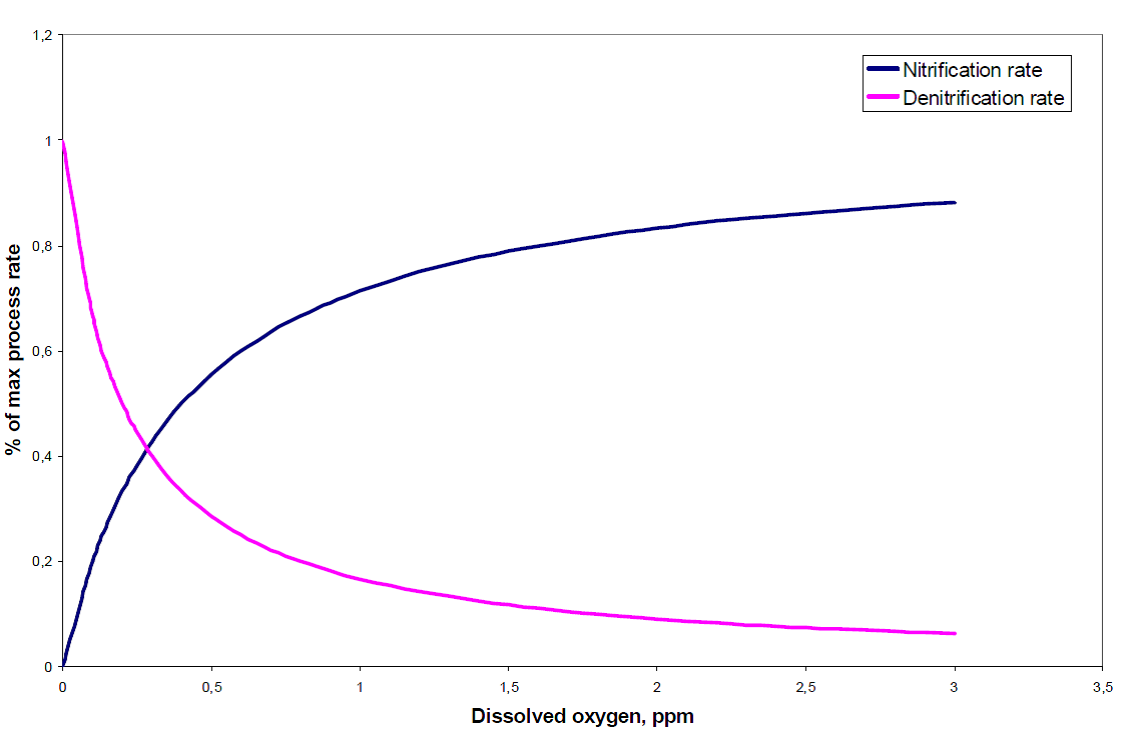
Figure 1. Nitrification and denitrification rate as a function of dissolved oxygen concentration. Source: Gustaf Olsson, Lund University, Sweden.
Feedback Control - Cascade
Nitrification and DO concentration are both optimized in a cascade control arrangement. The ammonium controller shown in Figure 2 compares the measured ammonium with the ammonium setpoint and calculates the DO setpoint which is forwarded to the DO controller. The DO controller compares the measured DO concentration with the calculated setpoint and calculates the required airflow which is forwarded to the airflow controller.
This requires tuning 4 control loops (pressure loop not shown) increasing the complexity of the control system. Alternatively, the DO controller may be set on top of the ammonium controller to limit the DO concentration to a maximum value. One potential problem with this configuration is that the two controllers fight over authority because the DO concentration changes faster than the ammonium concentration.
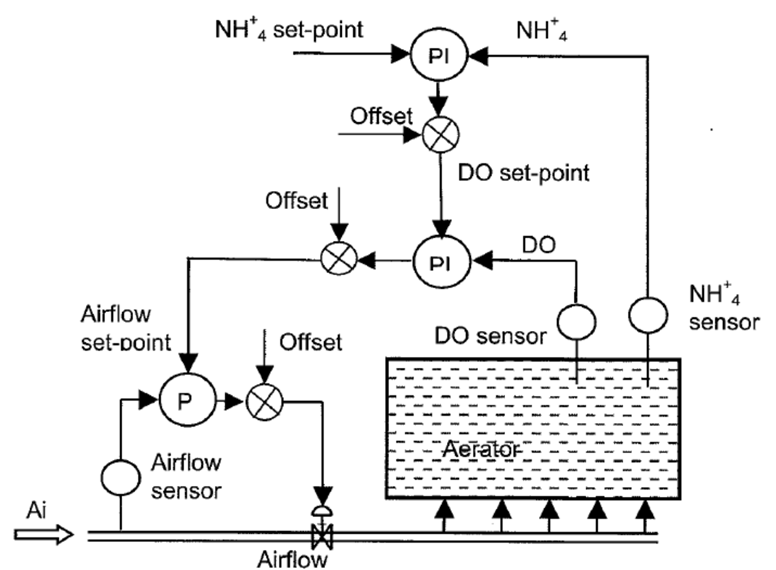
Figure 2. Cascade control of aeration with ammonium measurement. Reproduced G Olsson, M Nielsen, Z Yuan, A Lynggaard-Jensen, J-P Steyer (2005) Science & Technical Report No. 15, Instrumentation, Control and Automation in Wastewater Systems, with permission from the copyright holders, IWA publishing.
The proper location of the ammonium sensor(s) presents an additional level of complexity for plug flow (PF) reactors. In a CM configuration, sensor location is somewhat irrelevant because concentration is the same throughout the reactor. In a PF configuration, concentration varies along the length of the reactor with higher concentrations upstream and lower concentrations downstream. One philosophy is feedback control based on the measurement of effluent ammonium. This provides a direct indication of performance but a delayed control signal. By the time an effluent ammonium sensor detects a peak loading, it may be too late for a correction, especially for highly dynamic influent loadings and reactors with long retention times such as in single-stage nitrification.
The control system depicted in Figure 3 is based on a control signal from a DO sensor located at the effluent end of the aeration tank. Upstream ammonium (red line) spikes several hours before airflow (blue line) responds allowing DO to fall to undesirably low concentrations (green line). As a result, ammonium breaks through the effluent (purple line).
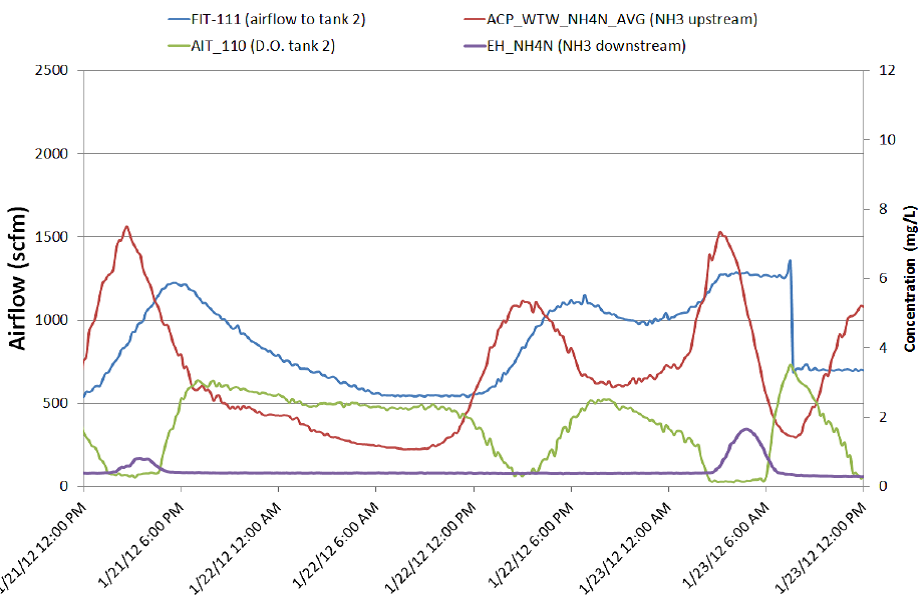
Figure 3. Feedback control of aeration based on effluent measurement. Poole, A.N., et al (2012). Comparison of Ammonia and DO Aeration Control Strategies to Optimize Energy and Performance at Low Capital Cost: A Case Study. WEFTEC. New Orleans, LA.
Locating the ammonium sensor upstream from the effluent offers a few advantages. First, the lag time for the control signal is reduced. Second, locating the ammonium sensor closer to the effluent increases the reliability of meeting performance goals. Third, maintenance of an ammonium ISE is easier at concentrations between 1 mg/L and 10 mg/L. As concentration decreases, “noise” becomes a higher proportion of the signal creating a very challenging environment for performing accurate calibrations (matrix adjustment) increasing operator frustration, and reducing measurement reliability.
The chart in Figure 4 is the result of a strategy to control the DO concentration in the main oxic zone based on feedback from ammonium sensors at the midpoint and end of the zone. The drivers for control were effluent quality and energy conservation. The goal was to conserve alkalinity, and more reliably meet effluent pH limits, by limiting nitrification only to the extent required to meet the ammonium limit which varied monthly. Energy conservation would be achieved by limiting the DO setpoint based, in part, on the ammonium measurement as follows:
If NH4-N > 1.5, then DO setpoint = 2.0;
If NH4-N <= 1.5, then DO setpoint = 0.5 mg/L.
The DO concentration ramps up within an hour of the beginning of the ammonium increase and DO is maintained near setpoints. An early trial of the strategy indicated the potential for an annual power savings of $50,0004. Zone control of aeration is critical to this strategy because it allows the input of oxygen to match the oxygen demand along the reactor. Many facilities currently lack independently-controlled aeration zones which increase the cost of implementation.
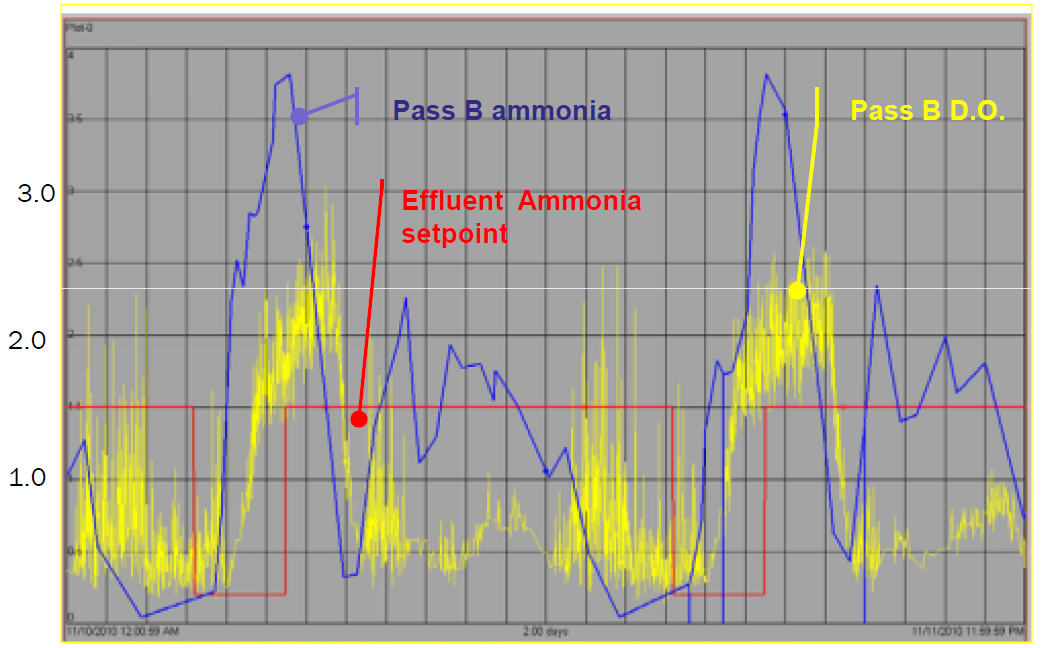
Figure 4. Feedback control with upstream ammonium sensors. Esping, D., (2012) Ammonia Controlled Aeration, Central States WEA 85th Annual Conference.
Feedforward Control
Feedforward aeration control is based on the upstream ammonium concentration. A model is required to predict the aeration rate required based on the upstream measurements. In the most extreme case, this would include a calculation of load from the influent ammonium concentration and wastewater flow. Simpler versions would include the measurement of ammonium concentration at upstream portions of the bioreactor and controlling the downstream aeration rate.
One particular control strategy based the blower output on the ammonium measurement at the head of a single-pass aeration basin. Above a setpoint concentration, blower output is directly proportional to the ammonium concentration. Otherwise, the blower maintains a minimum airflow to maintain mixing. Airflow closely follows the upstream ammonium concentration and the DO concentration is maintained near 2.0 mg/L a majority of the time. The strategy achieved the lowest unit airflow demand, 11% lower than with DO feedback control, achieving the main objective which was to reduce energy usage5.
The stated advantage of feedforward control is that the system reacts faster to a disturbance eliminating short-term effluent peaks and allowing a smoother control. The reality is that predictions are only as good as the model on which they are based and models are not perfect. Therefore, feedback from an effluent ammonium sensor is also recommended to correct for errors in the model. Some have stated that the benefit of feedforward aeration control does not, in most cases, provide substantial benefit over feedback control, and thus the additional cost and complexity are not justified6.
However, in cases where peak loadings are large and/or rapid and where effluent limits are very stringent, feed-forward control may offer a practical solution. Regardless, monitoring wastewater ammonium, and COD for that matter, online will provide very useful information on wastewater dynamics which can improve treatment whether or not the information is directly input to a control loop.
Summary
The foregoing discussion demonstrates that there are many potentially successful strategies for ammonium-based aeration control. It is not possible to identify a single strategy that will work for all utilities because there is great diversity in wastewater characteristics and the construction and operation of WRRFs.
Therefore, the proper solution for a given utility will undoubtedly have unique features. The important point is that wastewater utilities can be heroes instead of burdens by working towards a goal of energy neutrality. All the necessary elements for advanced control are now available and within the reach of any utility. The arrival of in situ ISEs to measure ammonium is an important development. This technology is mature and continues to improve. However, there is not a sensor in existence that doesn’t require an informed and properly trained technician. That is a discussion for another day.
1 Smith, R.C. (2013), “How to Control Activated Sludge with Online Sensors”, YSI Incorporated, https://www.ysi.com/ysi-blog/water-blogged-blog/2013/04/wastewater-process-control-which-strategy-is-right-for-you.2 Grievson, O. (2013), “Back to Basics - Control Strategies & PID Controllers”, WIPAC Monthly, www.wipac.org.uk, Issue 21.3 Biga, B, and Elberti, A. (2011), “Optimizing Nitrogen Removal with On-Line Ammonium Probes Reduces Costs and Earns Valuable Nutrient Credits”, Keystone Water Quality Manager, Pennsylvania Water Environment Association, July/August/September 2011.4 Brischke,K, Olds, K., Adams, D., Hardison, J., and Rieger, L., (2010) “Using Whey as a Supplemental Carbon Source under Real Time Control Conditions”, WEFTEC Annual Conference, New Orleans, LA.5 Poole, A.L., Neighbors, J., Green, D.J., Baert, S.E., Sosnowski, C.T., Wold, D.J. (2012), “Comparison of Ammonia and DO Aeration Control Strategies to Optimize Energy and Performance at Low Capital Cost: A Case Study”, WEFTEC Annual Conference, New Orleans, LA.6 Rieger, L., Jones, R.M., Dold, P.L., and Bott, C.B., “Myths About Ammonia Feedforward Aeration Control”, http://www.researchgate.net/publication/229429202_Myths_About_Ammonia_Feedforward_Aeration_Control/file/d912f500b32182ea0e.pdf, accessed online 2/21/14.
Additional Blog Posts of Interest:
Shortcut the Nitrogen Removal Process in Wastewater with UV Sensors
ORP Management in Wastewater as an Indicator of Process Efficiency
Wastewater Process Monitoring and Control | Increase Productivity and Efficiency
Wastewater Process Control - Which Strategy is Right for You?